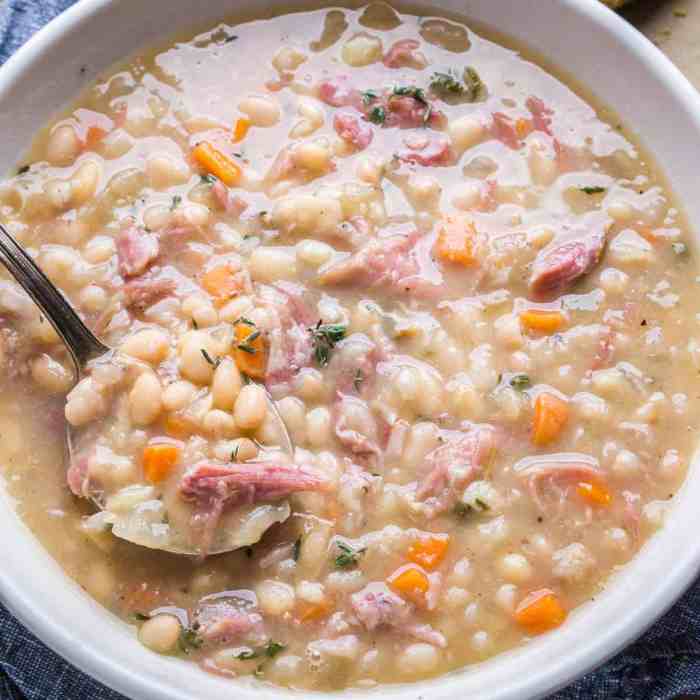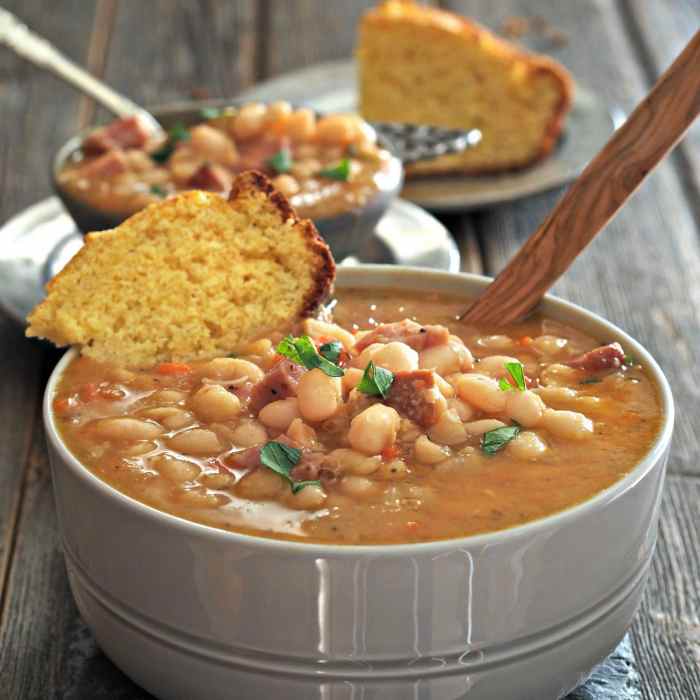Ham and Bean Soup Recipe Variations
Recipes for ham and bean soup – Ham and bean soup is a hearty and versatile dish, offering endless possibilities for customization. This section explores five variations, each showcasing a different bean’s unique flavor profile and cooking approach.
Bean Variations and Flavor Profiles
The choice of bean significantly impacts the overall taste and texture of the soup. Each bean brings its own distinct character.
- Kidney Bean: Earthy and slightly sweet, kidney beans provide a robust flavor and hold their shape well during cooking.
- Pinto Bean: Creamy and subtly sweet, pinto beans offer a mild flavor that complements other ingredients beautifully. They tend to become softer during cooking.
- Navy Bean: Mild and slightly starchy, navy beans create a smooth, comforting texture. They’re excellent for absorbing the flavors of the ham and broth.
- Black Bean: Rich and slightly smoky, black beans impart a deep, earthy flavor. Their firm texture adds a nice contrast to the soup.
- Great Northern Bean: These beans offer a delicate sweetness and creamy texture, similar to pinto beans but slightly less assertive in flavor.
Cooking Method Comparisons
While the basic principle remains the same, slight adjustments in cooking methods can enhance each bean’s unique qualities.
- Kidney Beans: Benefit from a longer simmer to develop their earthy flavors fully.
- Pinto Beans: May require pre-soaking to reduce cooking time and improve texture.
- Navy Beans: Cook quickly and readily absorb flavors, making them suitable for both stovetop and slow cooker methods.
- Black Beans: Their firm texture holds up well in longer cooking times, benefiting from low and slow methods.
- Great Northern Beans: Similar to pinto beans, these might benefit from pre-soaking for optimal texture.
Bean Soup Recipe Comparison Table
| Bean Type | Prep Time (mins) | Cook Time (hrs) | Estimated Ingredient Cost ($) |
|---|---|---|---|
| Kidney | 15 | 3-4 | 10-12 |
| Pinto | 20 (includes soaking) | 2-3 | 9-11 |
| Navy | 10 | 1.5-2 | 8-10 |
| Black | 15 | 3-4 | 11-13 |
| Great Northern | 20 (includes soaking) | 2-3 | 9-11 |
Ingredient Sourcing and Substitutions
The quality of ingredients directly impacts the final flavor of your ham and bean soup. This section explores sourcing and substitution options.
High-Quality Ingredients
For the best results, opt for high-quality ham bone, preferably from a butcher shop, ensuring a rich, flavorful broth. Choose dried beans over canned for a superior taste and texture, ensuring they are free from any damage or discoloration.
Ingredient Substitutions
Various substitutions can be made to accommodate dietary needs or preferences.
- Ham: Smoked turkey or chicken bones can replace ham for a lighter flavor profile.
- Beans: Lentils or other legumes can substitute beans, altering the texture and flavor subtly.
- Broth: Vegetable broth can replace ham broth for vegetarian versions.
Dietary Restriction Substitutions
Adapting the recipe for various dietary needs is straightforward.
| Dietary Restriction | Substitution |
|---|---|
| Vegetarian | Replace ham with vegetable broth and add mushrooms or other vegetables for umami |
| Vegan | Use vegetable broth, omit ham entirely, and ensure all other ingredients are vegan-friendly |
| Gluten-Free | Ensure all ingredients, including broth and seasonings, are certified gluten-free |
Cooking Methods and Techniques
This section details the step-by-step process for preparing ham and bean soup using a slow cooker and compares it to stovetop methods.
Slow Cooker Method
- Combine ham bone, beans, water or broth, and aromatics (onion, garlic, carrots) in a slow cooker.
- Cook on low for 6-8 hours or high for 3-4 hours, or until beans are tender.
- Remove ham bone, shred the meat, and return it to the soup. Season to taste.
Stovetop vs. Slow Cooker
Slow cooking results in a richer, more tender soup due to the long, gentle cooking process. Stovetop methods offer quicker preparation but might result in slightly less tender beans and a less intense flavor.
Common Mistakes and Solutions
- Overcooked Beans: Reduce cooking time or use pre-soaked beans.
- Bland Soup: Add more aromatics, seasonings, or a splash of vinegar or Worcestershire sauce.
- Thin Soup: Simmer uncovered for a while to reduce the liquid.
Tips for Optimal Consistency and Flavor, Recipes for ham and bean soup
- Use a good quality ham bone for rich flavor.
- Don’t be afraid to experiment with different herbs and spices.
- Taste and adjust seasonings throughout the cooking process.
Serving Suggestions and Pairings
Elevating the presentation and pairing ham and bean soup with complementary dishes enhance the dining experience.
Creative Serving Suggestions
- Garnish with fresh parsley, a dollop of sour cream, or a sprinkle of crispy fried onions.
- Serve with crusty bread for dipping.
- Add a side of cornbread for a classic Southern pairing.
- Top with shredded cheese for extra richness.
- Serve in individual bowls with a side of chopped green onions.
Complementary Side Dishes
- Cornbread: The sweetness of cornbread complements the savory soup perfectly.
- Simple Green Salad: A fresh salad provides a refreshing counterpoint to the hearty soup.
- Garlic Bread: Toasted garlic bread enhances the overall flavor profile.
Beverage Pairings

Source: thekitchengirl.com
A crisp, dry white wine or a light-bodied red wine would complement the soup’s flavors. Alternatively, a refreshing iced tea or a light beer would also be suitable.
Visual Description of a Perfectly Presented Bowl
Imagine a rustic bowl brimming with a deeply colored, amber-hued soup. Tender, perfectly cooked beans nestle amongst succulent shreds of ham. The aroma is rich and comforting, a blend of smoky ham, earthy beans, and fragrant herbs. The texture is hearty yet smooth, with a pleasant chewiness from the beans.
Nutritional Information and Health Benefits
Ham and bean soup offers a nutritious and satisfying meal. This section details its nutritional benefits and the nutritional comparison of different beans.
Nutritional Benefits
Ham and bean soup is a good source of protein, fiber, and various vitamins and minerals. Beans are particularly rich in fiber, promoting digestive health. The ham provides protein and essential nutrients.
Nutritional Comparison of Beans

Source: simplysated.com
The nutritional content varies slightly depending on the type of bean used. Generally, all beans are excellent sources of protein and fiber. However, certain beans might be richer in specific vitamins or minerals.
Health Benefits of Regular Consumption
Regular consumption of ham and bean soup can contribute to improved digestive health due to the high fiber content. The protein content supports muscle building and satiety, aiding in weight management. The various vitamins and minerals contribute to overall well-being.
Nutritional Information Table (per serving, approximate values)
| Nutrient | Amount |
|---|---|
| Calories | 250-300 |
| Protein (g) | 15-20 |
| Fat (g) | 5-8 |
| Carbohydrates (g) | 30-40 |
Helpful Answers: Recipes For Ham And Bean Soup
Can I use canned ham instead of a ham bone?
Yes, canned ham works well, but it might not impart as much depth of flavor as a ham bone. Adjust the salt accordingly.
How can I thicken my ham and bean soup?
A cornstarch slurry (cornstarch mixed with cold water) or a roux (butter and flour cooked together) can be used to thicken the soup. Add it slowly while stirring constantly.
How long can I store leftover ham and bean soup?
Store leftover soup in an airtight container in the refrigerator for up to 4 days.
What are some vegetarian/vegan substitutions for ham?
Vegetarian options include smoked tofu or mushrooms. For vegan options, use vegetable broth and consider adding smoked paprika or liquid smoke for a smoky flavor.
